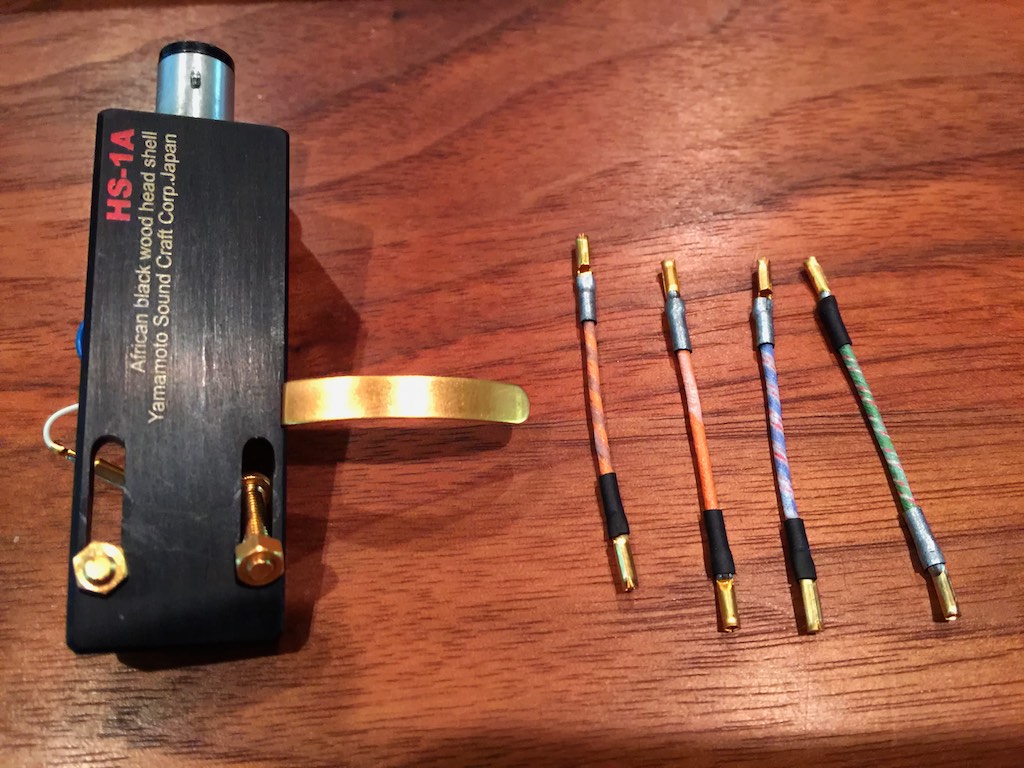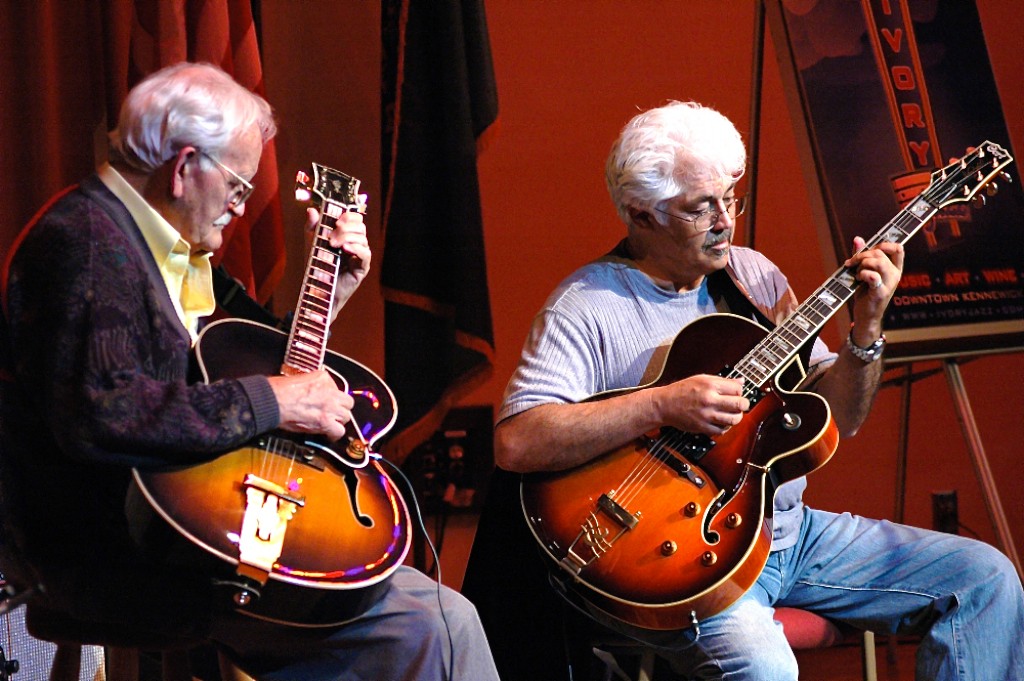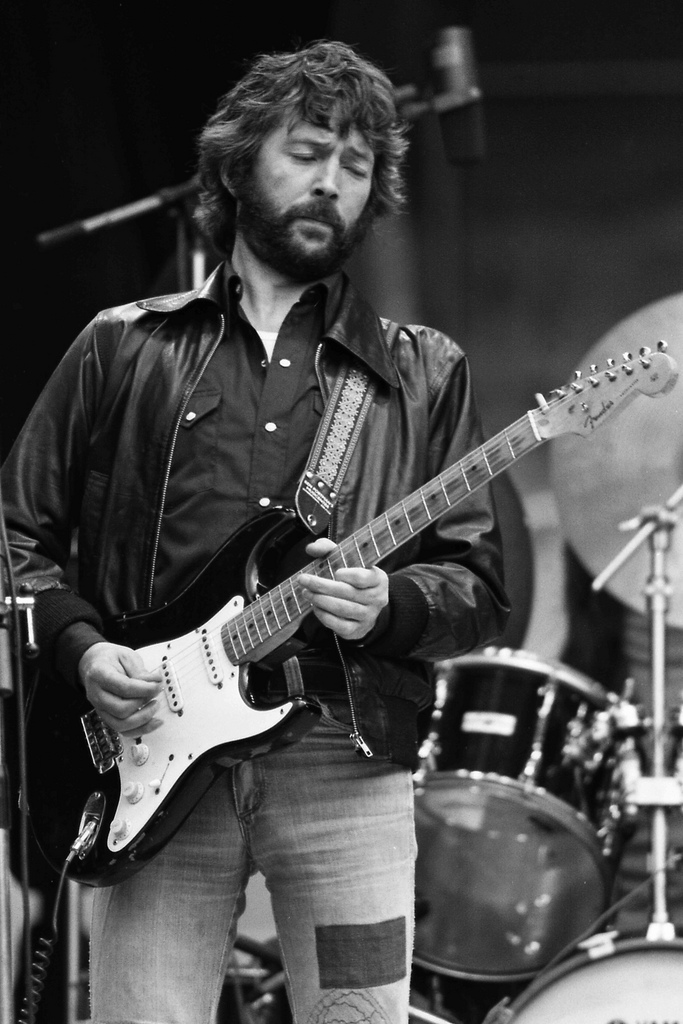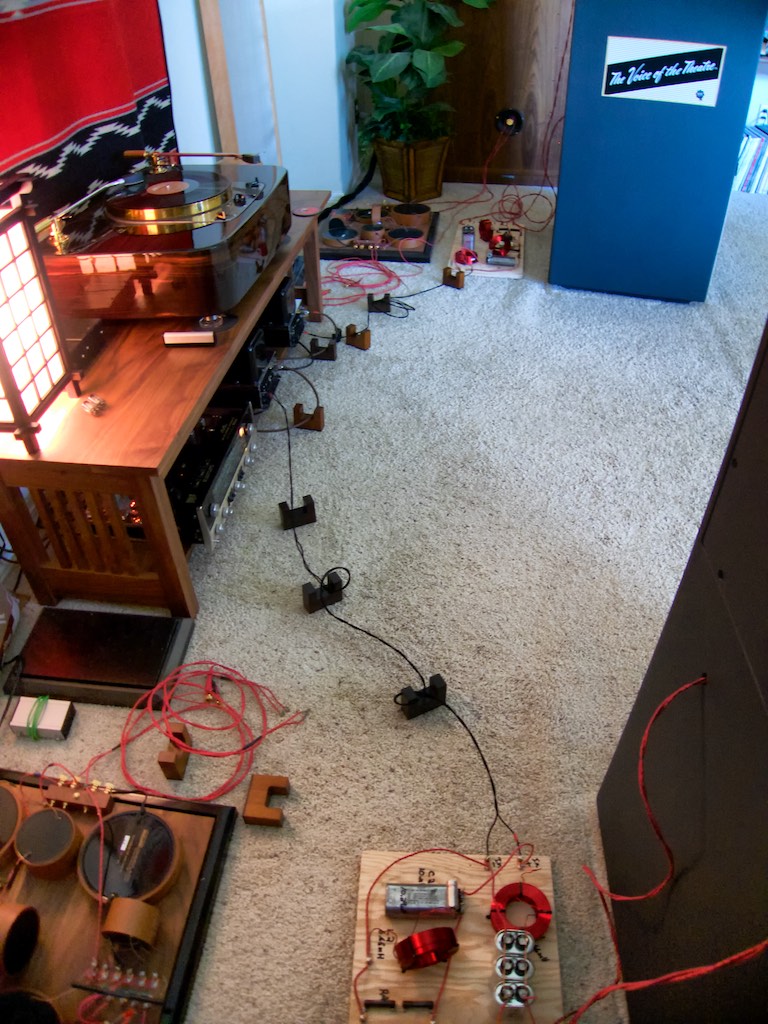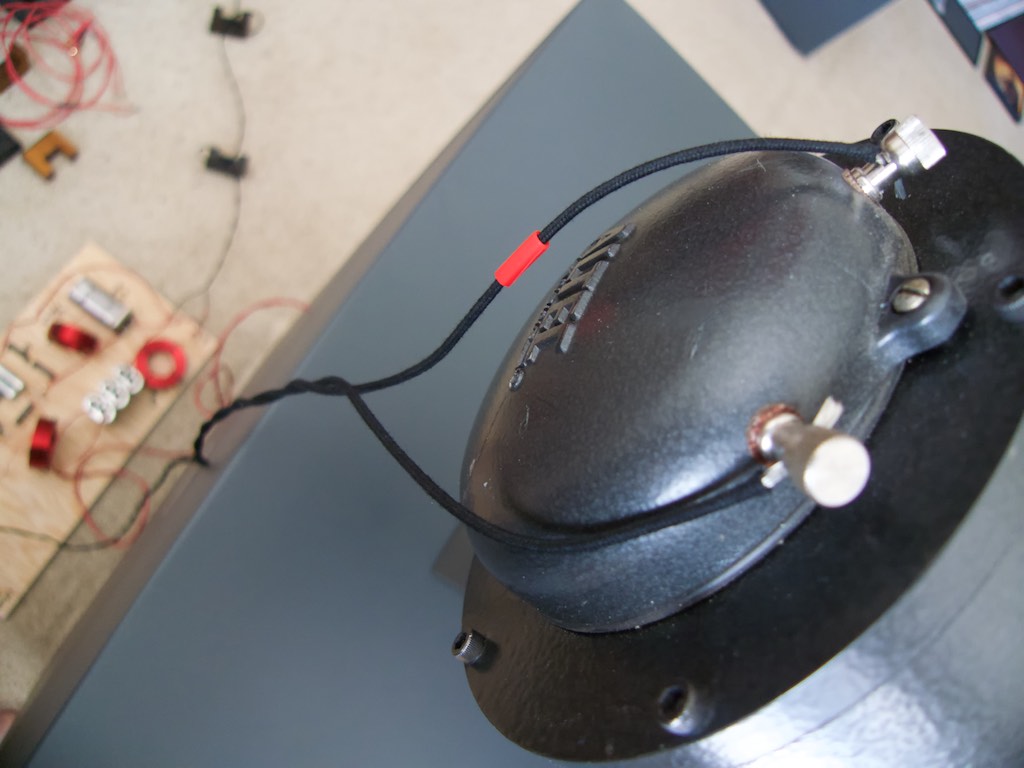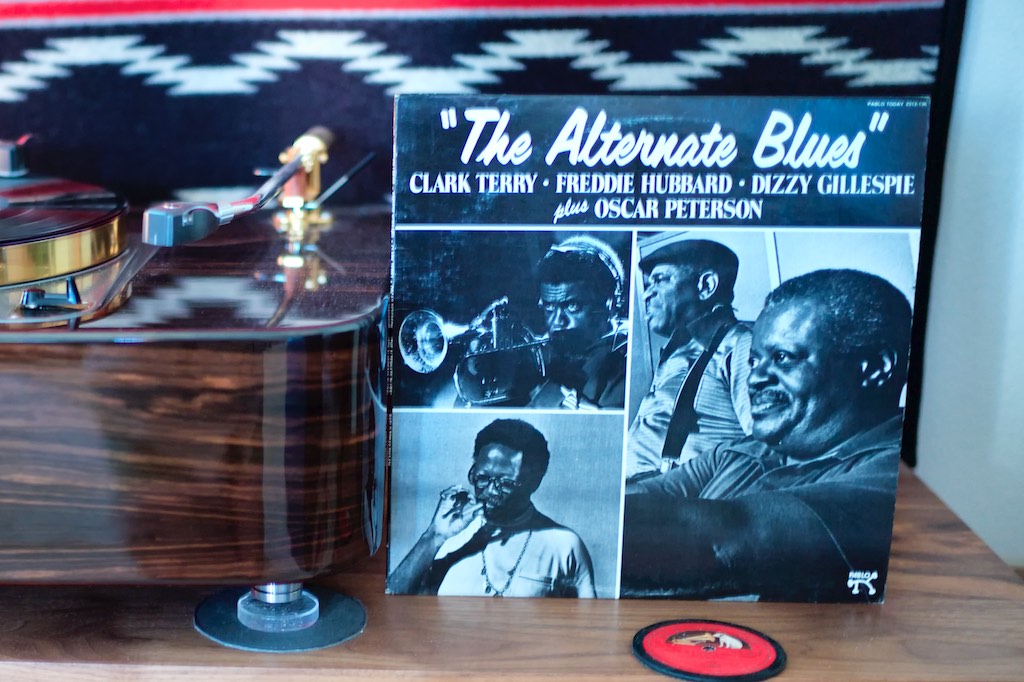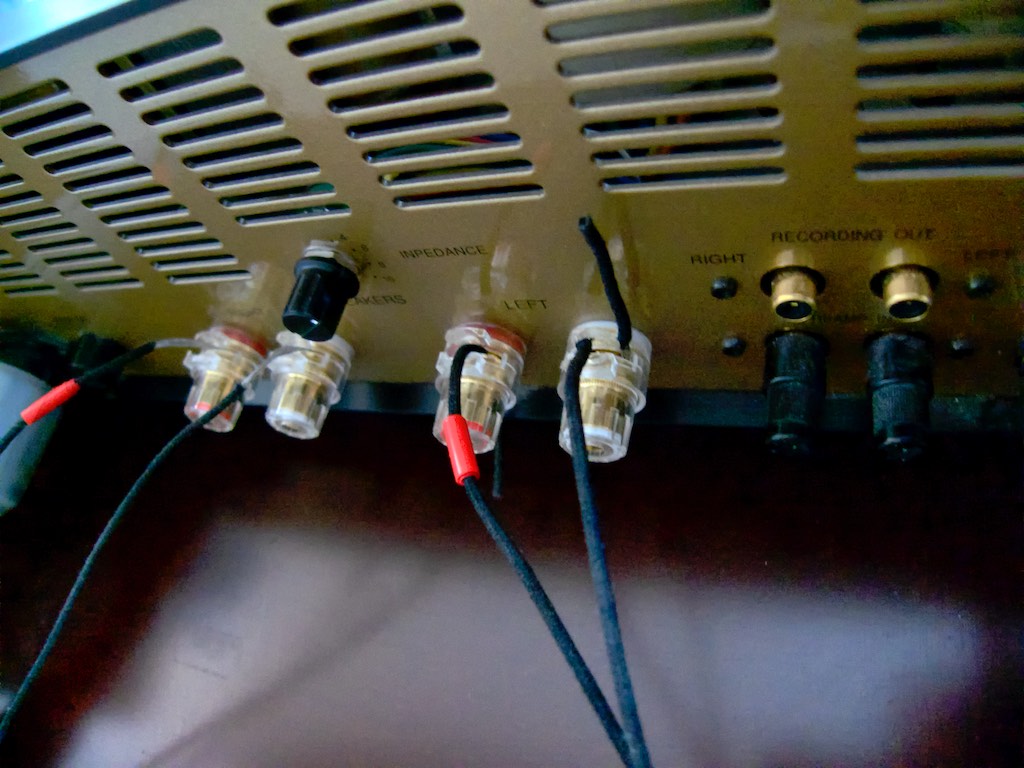It's always good to get home and fire up the stereo after being off on a long week of work travel. The first thing I did after getting home from a long day of flying was to plug in my vintage McIntosh vacuum tube electronics and vintage Altec A5 Voice of the Theatre loudspeakers based system to let it warm up for a while, pour a glass of nice French wine, and then listen to The Girl From Ipanema from the Getz/Gilberto LP, in honor of the Rio Olympics! Ah, the good life!
Please keep all your comments coming about your experiences with the speaker cables, interconnects, hookup wire, pushback wire, etc., that use tinned-copper conductors to juice up the music.
I suspect we are just beginning to scratch the surface of applications for the tinned-copper conductors 'vintage tone' style of wire.
It's really valuable feedback to hear about what you are hearing/feeling based on your associated equipment and personal tastes, and I think it will be a valuable resource for like-minded enthusiasts for future reference.
With the huge wave of popularity I'm seeing for wire containing tinned-copper conductors, with its 'vintage tone' tonal balance, I'd say we're seeing something rather remarkable happen, a sort of renaissance for the 'vintage tone' style of wire, with its rather remarkable ability to emphasize the musicality & emotional connection to the music, while still sounding good sonically, with the added bonus of being relatively inexpensive. That's a mighty fine combination if you ask me.
I thought it would be useful to recap what I've learned over the last year or so about tinned-copper 'vintage tone' wire, and summarize your findings and recommendations as well (let me know if I've missed anything).
First of all, I'd like to acknowledge and thank Yazaki-san from the SPEC Corporation for introducing us all to the charms of this tinned-copper 'vintage tone' style of wire in the form of vintage-style Belden 8402 microphone cable for use as interconnects, vintage Western Electric WE16GA for use as speaker cables, and vintage Western Electric WE24GA for use as headshell wires. Thank you, Yazaki-san!
When I first tried the Belden 8402 microphone cable as interconnects, and the vintage Western Electric WE16GA as speaker cables, Yazaki-san had warned me to be patient, as tinned-copper wire tends to sound a little ‘rough’ and brash, and a little flat dimensionally, during its initial settling-in period, before it comes on song musically & sonically.
I have found that initial 'roughness' to be almost universally true with the tinned-copper conductor wire trials I have done to date, although the Duelund DCA16GA surprised me when I tried it as speaker cables, as it sounded good from the start (as speaker cables), but when I tried the DCA16GA as runs from the Hiraga-san inspired A5 crossovers to the combination of my 16-Ohm Altec 288C Alnico high-frequency compression driver and Altec 1005B ten cell high-frequency horns, I heard that same initial 'roughness' and settling-in period that is the norm for tinned-copper conductor wire.
So let me give you a friendly heads-up to be patient with tinned-copper conductor wire like the WE16GA (in particular), Belden 8402 microphone cable, tinned-copper pushback wire, and Duelund DCA16GA, as it tends to go through a ‘phase change’ musically & sonically after a period of time (usually around 100 hours), then slowly gets better over an extended period of time. I have found this to be a much greater magnitude of change than you normally get with wire run-in, for whatever reason.
Over time I've had one, maybe it was two people, tell me they disliked the 'vintage tone' style of wire, and I suspect it was because they didn't give it adequate time to run-in, settle down, and get over that initial period of 'roughness' that seems to be common to this 'vintage tone' style of tinned-copper wire. But in any event, give your 'vintage tone' style of tinned-copper wire plenty of time to settle down so you can hear it at its best.
As an aside, I've also found that when you take 'vintage tone' tinned-copper wire out of the system, then put it back in, it takes it a while, usually a couple of days, to get back on song again. This is particularly trying for reviewers who change their systems a lot in the reviewing process, but for the rest of you it shouldn't be an issue, and I recommend you put the wire in place and then don't touch it unless you absolutely have to.
There’s always a chance that a listener just will not like what it’s about musically & sonically, of course, as I’m sure there are contexts where the ‘vintage tone’ style of tonal balance won’t match well with associated equipment or a given music lover’s tastes, but so far that's been a pretty rare occurrence.
Ok, back to the story.
After listening to the Belden 8402 microphone cable and Western Electric WE16GA for a while, I also noticed that my vintage McIntosh vacuum tube components were all wired internally with vintage Western Electric wire, so I began to wonder if there was a distinctive tonal voicing that was more-or-less typical of tinned-copper conductors, much in the same way that copper, silver, and gold wire have distinctive tonal signatures.
As I began to do a little research on the topic, I found out that the guitar guys had come to the same conclusion, quite a while ago, and that they used the term 'vintage tone' to describe the vintage tonal balance of tinned-copper conductors that were used in vintage electric guitars like the Gibson L5 or Les Paul, and the Fender Stratocaster, as well as in those vintage vacuum tube guitar amplifiers that gave those guitars their distinctive voices.
I thought the guitar guys had some keen insight into this, so I appropriated their term 'vintage tone' to describe the tonal balance of tinned-copper wires for audio use as well.
The guitars guys are still quite a bit ahead of us in audio in recognizing the importance of a 'vintage tone' tonal balance in conveying musicality and emotive qualities in music, and recognizing how different components, like 'vintage tone' capacitors (among other things), influence musical performance, like the vintage Bumblebee caps, the new production Jupiter 'Red Astron' tinfoil caps (I'm loving them in my MX110Z!), Alnico magnets like my Altec A5's & A7's have, and the like. You can read more of my musings on this topic here.
I've already mentioned the beautiful 'vintage tone' balance of vintage Western Electric WE24GA used as headshell wires, and I'm very enthusiastic about the 'vintage tone' USB interconnect I made from tinned-copper pushback wire, and reported on here. As a follow-on comment to my 'vintage tone' USB interconnect, let me just say that while it has gone relatively unnoticed by most of you, it absolutely kills any other USB interconnect musically that I've tried to date, and it cost pennies to make. Just sayin'.
Well anyways, after trying the Western Electric WE16GA as speaker cable, I slowly replaced the wire I had used to wire my Duelund CAST crossovers for my Westminster Royal SE loudspeakers with Western Electric WE16GA, followed by replacing the internal wiring of my Westminster Royal SE loudspeakers with Western Electric WE16GA. The WE16GA provided the same excellent results in those applications as well.
I also did the same thing for my Stokowski Altec A7 Voice of the Theatre loudspeakers and SPEC RSA-M3 EX Real Sound Amplifier based system, and using Western Electric WE16GA wire as speaker cables, Belden 8402 microphone cables as interconnects, and the aforementioned tinned-copper pushback wire USB interconnect. That system sounds fantastic wired up with all 'vintage tone' wire.
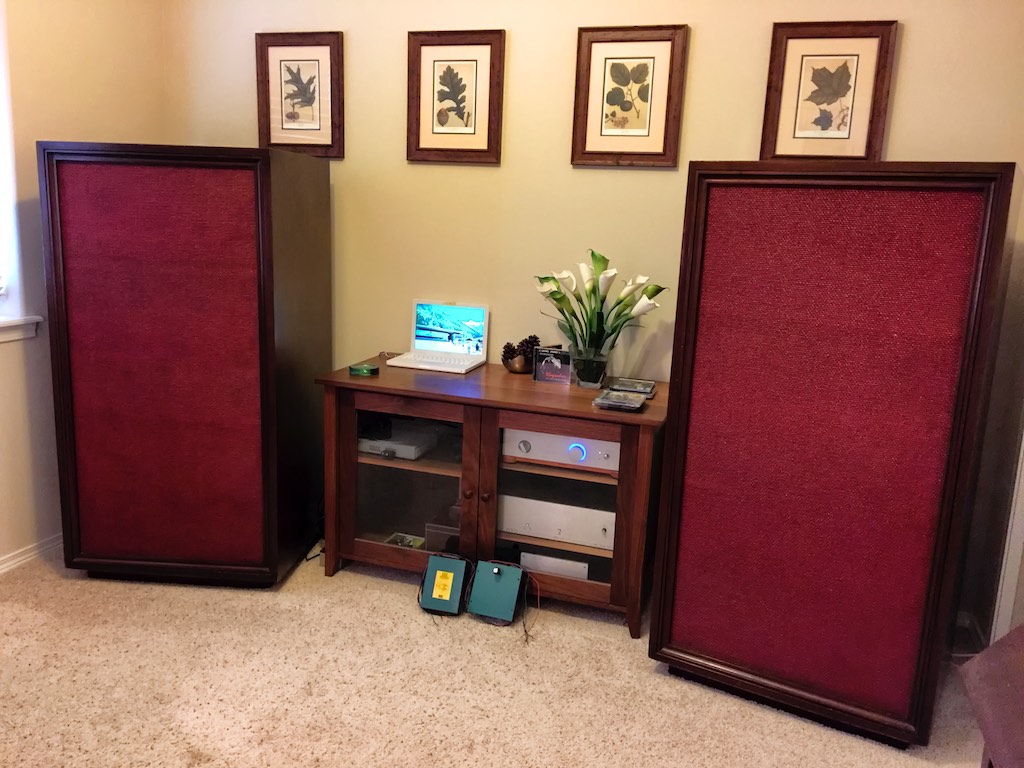
My A7 VOTTs that were custom built for Leopold Stokowski absolutely sing with 'vintage tone' style of wire as interconnects and speaker cables!
When I started my Altec A5 project I didn't mess with success, and used the Western Electric WE16GA for speaker cables, crossover wiring, and to wire the Altec drivers. It worked great as I had hoped it would.
It was during this period of time that I was talking with Frederik Carøe at Duelund Coherent Audio in Denmark about my experiences with the vintage Western Electric WE16GA tinned-copper wire, and was lamenting the fact the genuine vintage Western Electric WE16GA was all but extinct.
Fortunately for all of us, Frederik became intrigued with the idea of re-introducing a 'vintage tone' style of wire using tinned-copper conductors, and modeled it after the now legendary (and extinct) Western Electric WE16GA, utilizing the same number and size of tinned-copper conductors, but going the vintage Western Electric one better by using an oil impregnated and baked cotton dielectric, instead of the Western Electric's fabric & plastic dielectric. Frederik worked really hard to keep the retail price low too, about what I payed for my WE16GA, which is truly commendable.
As you know, I've been very pleased with the performance of the Duelund DCA16GA on my Altec A5 Voice of the Theatre loudspeakers as speaker cables, and going from my Hiraga-san inspired crossovers to my Altec AlNiCo 288C high-frequency compression drivers.
Given the length of time it takes to get the full measure of performance from a 'vintage tone' tinned-copper wire, I'm being patient in letting the Duelund DCA16GA settle in, and I don't think I'm anywhere near hearing its full potential yet. I'm also taking my time gathering listening impressions in an effort to come to grips with articulating why the tinned-conductor Duelund DCA16GA 'vintage tone' style of wire sounds so compellingly musical, and conveys so much of the emotive aspect of music.
As I mentioned earlier, the MSRP retail price of the Duelund DCA16GA is $12.99 USD/meter ($3.97/ft), but I understand that Parts Connexion’s standard pricing will be 15% off this or $10.99 USD/meter ($3.37/ft.), so that’s a great deal for what is essentially a custom, hand-assembled, 16 AWG tin-plated stranded copper wire made to Western Electric WE16GA standards, with an oil impregnated cotton jacket as a bonus.
I do have some bad news for you regarding the Duelund DCA16GA, so I guess I'd better break it to you now. In a market starved for a quality 'vintage tone' style of wire, the entire first production run of the Duelund DCA16GA wire sold out only 6 days after my first post about it. Frederik has geared up to do a second production run, and as I mentioned the first time around, be sure to get your name on Parts Connexion's waiting list so you don't miss out on the second production run too.
I'm sitting here listening to The Alternate Blues as I'm writing this update for you, and I've been playing it over and over, and it's just blowing me away with how musical and 'real' it sounds. I think I've played the entire album about four times now, and lets just say the the Duelund DCA16GA is bringing out the best in it.
Ok, well I've got to get on with my day and the onslaught of tasks that need catching up on, so I've got to run.
Update for Saturday Evening: I just cut a pair of 3-meter Duelund DCA16GA speaker cables to use from my Leben CS600 integrated amplifier to my Harbeth Super HL5 loudspeakers. Just as with the 2-meter Duelund DCA16GA speaker cables I cut for my Altec A5 Voice of the Theatre loudspeakers, they sounded good right off, being warm, rich, and nicely textured, which surprised me a bit, as usually tinned-copper sounds rough before it settles in.
As an aside, about two weeks ago I had one of the Electro Harmonix KT90EH tubes fail that I had been using in my Leben CS600. I liked the KT90EH tubes in the Leben CS600 a lot, as they were warm, with rich timbral textures, and deeply infused tonal colors. When one of the big KT90EH tubes failed, I pulled them all out and replaced them with a quad of 6n3cEs that I had used previously in my CS600. The 6n3cEs are nice sounding tubes in the CS600, but with a leaner, brighter, and more detailed presentation.
Even with the 6n3cEs in my CS600, the addition of the Duelund DCA16GA provided an even warmer, timbrally richer, and more colorful sound, than with the quad of KT90EH tubes I was using earlier. Nice.
Harbeth and Leben owners take note!
Update for Sunday Morning: I thought I'd add a couple of photos to show you how I hooked up the Duelund DCA16GA wire as speaker cables to my Harbeth Super HL5's binding posts.
If you look closely at the photo, you'll see I cut the oil-soaked/baked cotton dielectric and pulled it apart just enough to match the spacing between the SHL5's binding posts, threaded the DCA16GA wire through the low & high-frequency posts, then snugged them down. I described this studio wire tip in my post A Handy Western Electric WE16GA Tip! here.
You have to be a little careful with the casing so you don't pull it off the end, because if you do you'll never get it back on. I was thinking it might be a good idea to use a tiny drop of glue on the dielectric ends where it's touching the wire to keep it in place, but I haven't tried that yet.
By the way, I recommend that when using the Duelund DCA16GA for speaker cables you resist the temptation to terminate the wires with spade or banana connectors, as I have found (when using the WE16GA) that even the best of them seriously degraded the quality of the sonics & musicality.
Also, try to resist the temptation of using a bi-wire set. There's a mindset in audio that says 'more must be better' so we bi-wire. Yazaki-san was telling me one day (I hope I'm not misquoting you, Yazaki-san), that he preferred the use of a single run of WE16GA wire as speaker cables, and thought the performance with a single wire was better performing in a 'real sound' way with his Altec's than a bi-wire arrangement.
Essentially, little skinny tinned-copper 16GA wires work great with high-sensitivity horns and tube amplification. It turns out they also work great with my Stokowski Altec A7 VOTTs and solid-state SPEC amplification, and now I know that the single run of skinny wires formula also works well with my low-sensitivity Harbeth Super HL5 loudspeakers and Leben CS600 amplification.
Yazaki-san has been politely trying to nudge people in that direction of 'less is more' and I think he's got a good point. Give it a try and see what you think, it's a very cost effective way to get 'real sound' performance.
If you must try a bi-wire arrangement to satisfy your curiosity, please do so (I did), and you might find there are applications where you like it better. Even if you don't, I'm sure Frederik will appreciate you purchasing extra Duelund DCA16GA wire to support the 'vintage tone' wire movement!
The Duelund DCA16GA wire sounds incredibly good on my Leben CS600 integrated amplifier and Harbeth Super HL5 loudspeaker system.
That's with zero run-in time, which just goes to show that maybe the Duelund DCA16GA with its oil-soaked/baked cotton dielectric isn't as fussy as the Western Electric WE16GA's fabric/plastic dielectric is about that initial run-in roughness, although I'm not completely convinced about that yet. Time will tell.
Now I want to add a pair of Belden 8402 microphone cable RCA interconnects to the mix and see what happens! I just ordered a pair of 2-meter Belden 8402 microphone cable interconnects from BTPA.com, with the Switchcraft 3502AAU (Gold Plug/Nickel Handle) RCAs, and with the screen connected to the ground on both ends as per Yazaki-san's method. With shipping the cost came to $89.60 - what an incredible bargain!
More to come.
Have fun listening and keep me posted on your experiences and impressions.
Over and out!







